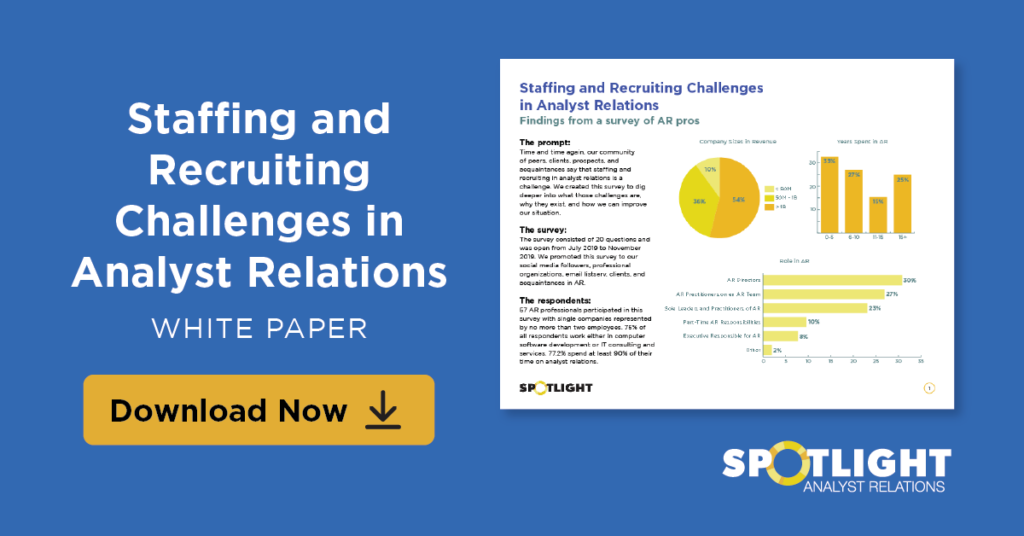by Andrew Hsu
February 26, 2020

When we sat down to review the data from our inaugural staffing and recruiting challenges survey, we were intrigued to see whether the data would confirm our suspicions or if the data would surprise us.
What didn’t surprise us is that most AR teams feel understaffed. Nor did it surprise us that most of those understaffed teams didn’t have enough approved job openings to fill those needs. Also not surprising is that AR pros prioritize influencing analysts over learning from analysts to the tune of 3:1.
What did surprise us was the substantial disconnect between how AR directors perceived the hiring challenge and how their executive sponsors perceived the hiring challenge. The data show that AR directors are primarily looking to hire hands-on managers to alleviate immediate workload. AR executive sponsors, on the other hand, want more experienced and strategic hires.
Reflecting on this disconnect on hiring, a couple of thoughts immediately came to mind. The first was that we needed to spin up a research project in order to validate this finding and to better understand the expectations executives have of AR. The second was that an expectation gap around hiring of this magnitude likely hints at a deeper and broader expectation gap for the whole channel.

If we revisit the data on underfunded hiring through this lens, it is disconcerting that so many of us are struggling to provide enough perceived value to justify sufficient investment. What is the gap between what we’re delivering and what executives value? Are we bad at what we do? Are we doing the wrong things?
In this period of historic, sustained growth and unprecedented financial investment in enterprise technology, there doesn’t seem to be an obvious reason that a critical function like AR should be underfunded.
Spotlight supports just under 100 AR programs today, and the AR pros we work with and for are more sophisticated and competent than ever. We see no evidence that AR teams are systemically failing to execute good AR against traditional AR objectives. Almost all programs we observe are managing interactions, building relationships, pursuing evaluative reports, running analyst events, and managing subscriptions and reprint investments with good consistency.
Our survey data show that AR pros prioritize Earn metrics (number of leads, improved dot placement, etc.) 3:1 over Learn metrics (informed roadmap, improved messaging, etc.). Is our just-get-more-leads instinct right? Or should we be shifting our emphasis – or adding emphasis – towards the Learn side of the equation? How much more value can we uncover if we’re (more) systematically collecting and sharing analyst insights with our product, marketing, and sales decision-makers?
I’m not proposing that we ditch wholesale the things we’ve always done, but the data suggest that regardless of how good we’ve become at maximizing dot placement and fueling marketing, it’s not seen as enough. It begs the question, would it be enough if we captured the full value of AR on both sides of the equation?
In order to support a shift to better balance Earn and Learn, we’d also have to adjust our metrics to match. There might be an ancillary benefit that Learn metrics are more within our control than Earn metrics. We may not have control over how often an analyst writes (coverage), the strength of our product (placement), or how often an analyst makes a recommendation (leads) – but we do have control over how often we learn, who we learn from, what questions we ask, and who we share that knowledge with.
The “just add more Learn” theory proposed here is oversimplified by necessity, but we think the idea warrants serious exploration. In order to gather more experience and proof points, we will be working with a number of our clients to include insight-discovery metrics as targeted AR outcomes. I look forward to seeing how the executive teams at these clients react to this evolution of AR’s mandate.
If your program has already gone down this path of establishing formalized learning processes and supporting metrics, I’d love to learn more from you. Have you seen a positive impact in your firm? Are your leaders using these analyst insights to fuel decision making? Have you seen stronger and broader executive support for AR?
If you haven’t gone down this path yet but are interested in exploring the idea, I’d love to chat as well. What barriers do you see to execution? How can we overcome them?
Looking forward to continuing the conversation.